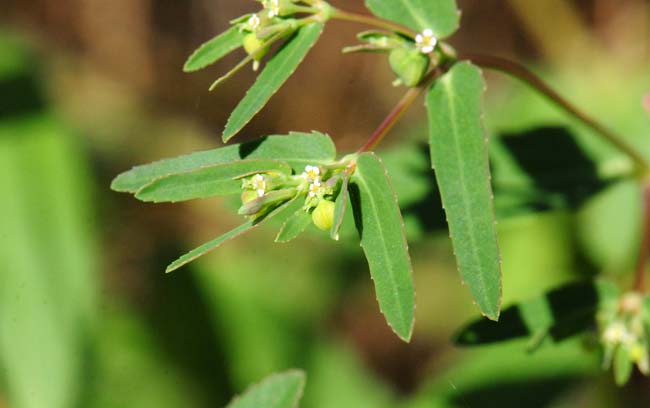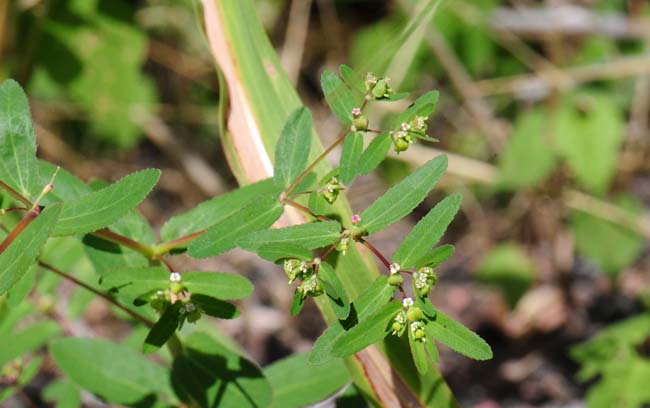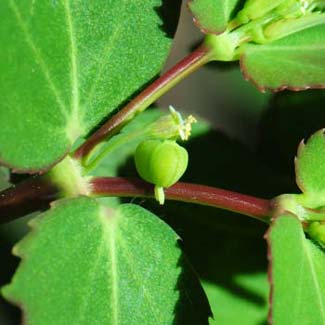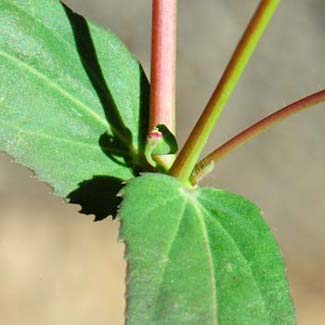Chamaesyce hyssopifolia, Hyssopleaf Sandmat




Scientific Name: Chamaesyce hyssopifolia
Common Name: Hyssopleaf Sandmat
Also Called: Hyssop Spurge, Leafy Spurge; (Spanish: Golondrina)
Family: Euphorbiaceae, Spurge or Euphorbias Family
Synonyms: (Anisophyllum hyssopifolium, Chamaesyce brasiliensis, Euphorbia brasiliensis, Euphorbia hyssopifolia)
Status: Native
Duration: Annual or Perennial
Size: Up to 8 inches or more.
Growth Form: Herbaceous forb/herb; sub-erect or ascending, glabrous, slender branching stems from base, red or green, milky sap, poisonous.
Leaves: Light green; opposite, finely serrated, leaf longer than wide, about ½ inch long, large spaces between leaves, asymmetrical at base, glabrous.
Flower Color: White petaloid small appendages, mostly glabrous, inflorescence resembles a "flower", flowers clustered from axils, actual flowers small or inconspicuous, monecious, botanically the "flower" is a cyathium; fruit a glabrous capsule.
Flowering Season: August to November.
Elevation: 1,000 to 6,000 feet.
Habitat Preferences: Sandy areas.
Recorded Range: Hyssopleaf Sandmat may be found growing naturally in the southern most United States in the border states of: AL, AR, AZ, FL, GA, HI, LA, MD, MS, NC, NM, SC, TX and the interior states of AR and UT. In Arizona, it is found in the northern, central and southern parts of the state.
North America & US County Distribution Map for Chamaesyce hyssopifolia.
U.S. Weed Information: No information available.
Invasive/Noxious Weed Information:No information available.
Wetland Indicator:In North America Chamaesyce hyssopifolia is included on the USDA 2012 National Wetland Plant List as a: Facultative (FAC) and Facultative Upland (FACU) species.
FAC, Facultative, occur in wetlands and non-wetlands
FACU, Facultative Upland, usually occur in non-wetlands, but may occur in wetlands.
Threatened/Endangered Information: No information available.
Comments: Hyssopleaf Sandmat is one of the most common sandmats in the southernmost United States. Keen observers in cities, towns and other urban areas will quickly recognize this non-aggressive "weed" species perhaps from their own yard. It is a striking rather handsome looking plant with its slim red or green nodding stems, bright green leaves outlined with attractive serrated margins and small but showy “flowers” and fruits.
In Southwest Desert Flora also see: Chiricahua Mountain Sandmat, Chamaesyce florida, Whitemargin Sandmat, Chamaesyce albomarginata; Arizona Sandmat, Chamaesyce arizonica; Head Sandmat, Chamaesyce capitellata; Royal Sandmat, Chamaesyce dioica; Red-gland Sandmat, Chamaesyce melanadenia; Carrizo Mountain Sandmat, Chamaesyce pediculifera; Threadstem Sandmat, Chamaesyce revoluta and Yuma Sandmat, Chamaesyce setiloba.

